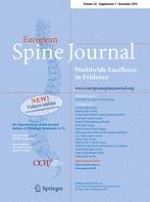Erschienen in:

01.11.2015 | Original Article
Spinopelvic balance and body image perception in Parkinson’s disease: analysis of correlation
verfasst von:
Luciano Bissolotti, Federica Isacco-Grassi, Claudio Orizio, Massimiliano Gobbo, Pedro Berjano, Jorge Hugo Villafañe, Stefano Negrini
Erschienen in:
European Spine Journal
|
Sonderheft 7/2015
Einloggen, um Zugang zu erhalten
Abstract
Purpose
The purpose of this study was to describe the association between body image perception and sagittal balance (SB) parameters in Parkinson’s Disease (PD) patients.
Methods
77 consecutive PD patients were included: 44 males, 33 females; 68.9 ± 6.8 years; 5.3 ± 3.8 years from diagnosis (YFD); Hoehn Yahr (HY) 2.0 ± 0.8, Unified Parkinson’s Disease rating Score-Motor section (UPDRS-M) 11.8 ± 9.3. Spinopelvic angles and SB were radiographically assessed. Body image perception was assessed through Trunk appearance scale (TAPS) and Stunkard Figure rating scale for BMI. Beck Depression Inventory (BDI) was used to evaluate depressive mood.
Results
We detected 32 (41.5 % of cohort) Parkinson Disease patients with scoliosis ≥15° Cobb. The mean calculated BMI was 27.1 ± 3.9 kg/m2. According to the Figure Rating Scale, the perceived BMI averaged 27.2 ± 4.5 kg/m2, while the mean desired BMI was 24.4 ± 2.7 kg/m2, TAPS scored 3.4 ± 0.9 points, while BDI 12.3 ± 7.9 points. TAPS had a weak negative correlation with the duration of disease (r = −0.25, p < 0.05) and a correlation with H&Y score (r = 0.28, p < 0.05). Sacral Slope was weakly correlated to the calculated BMI (r = −0.24, p < 0.05). SSA and SPA had a negative correlation with the TAPS mean score (respectively, r = −0.36 and −0.24, p < 0.05). BDI presented a weak correlation with TAPS (r = 0.27, p < 0.05) but not with self esteemed BMI values (p > 0.05).
Conclusions
Spinopelvic parameters and depression had a specific and concurrent influence on trunk deformity perception but not on BMI self-esteem.